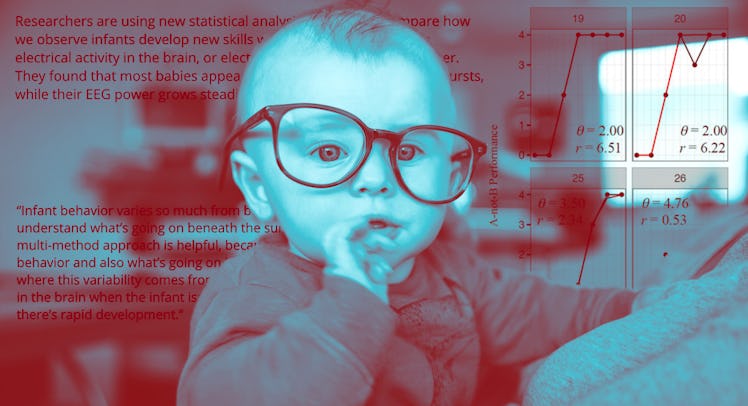Scientists Finally Explain Why Babies Seem Both Very Smart And Very Stupid
If infants seem to acquire new skills overnight, it's not in your head. It's in their head.

As exciting as it may be for parents to see their babies learn something instantly, a new study confirms that infants who pick up skills quickly aren’t actually geniuses. According to findings published this week in Child Development, speedy skill acquisition is a product of how babies observe and learn from those around them. On the surface, babies seem to develop cognitively in bursts — suddenly, for instance, learning how mechanical toys work — but, in reality, they are constantly working on these riddles. Babies seem like they have strokes of genius. They do not.
“This is a question that has bedeviled psychologists for most of the last century. Our data help show how behaviors that we can observe in children are indeed non-linear, showing up in spurts,” study coauthor Koraly Perez-Edgar, professor of psychology at Penn State, said in a statement. “However, the underlying forces that help support this observed behavior can be linear. For a long time there was a debate over whether both of these things could hold true.”
As Perez-Edgar notes, psychologists have thought for some time that cognitive development in children occurs in large spurts, rather than gradually in small doses. Although famous child psychologist first Jean Piaget first theorized this 1936, it wasn’t until nearly century later that Perez-Edgar and colleagues actually studied it. And it wasn’t until they tested it that they confirmed that that linear and non-linear growth are not mutually exclusive.
To do this, researchers recruited 28 6-month-old infants (14 boys and 14 girls) and brought them in the lab for testing once a month until they turned a year old. During each session babies were given a cognitive test, known as the “a-not-b” test, developed in the 1950s to measure a baby’s ability to understand object permanence. Infants’ electroencephalography scores were also measured using six electrodes during each visit.
Specifically, Perez-Edgar and colleagues places a box with two wells (well A and well B) across from the infant. Researchers would put a toy in one well, and covered it with a cloth out of site. In order to pass the test, babies had to correctly retrieve the toy twice from well A, and once from well B, after it was hidden.
After running the data through several statistical analyses, researchers found that there was not a lot of development at six months or a year, but there was a significant spike in babies passing the cognitive tests between seven and 11 months. Results similarly indicated that EEG power increased steadily during the same period of development. This suggests to researchers that development on the surface does happen in bursts, but more gradually below the surface. That’s why when kids start talking, they seem to learn words overnight, but their brains have been slowly listening, thinking, and processing them for some time.
It’s important to note that there are limitations to the current study, such as the small sample size and the fact that infant’s EEG scores were taken separate from the cognitive tests as opposed to during. Still, the findings as well as the methodology shed light on a new way to approach developmental research by operating on the hypothesis that large bursts and gradual growth somehow work together.
“This multi-method approach is helpful, because we can see both the infants’ behavior and also what’s going on in the brain,” study coauthor Leigha MacNeill, Penn State graduate student in psychology, a in a statement. “It gives us a better sense of where this variability comes from, and can help us see what’s happening in the brain when the infant isn’t getting better at the task verses when there’s rapid development.”
This article was originally published on